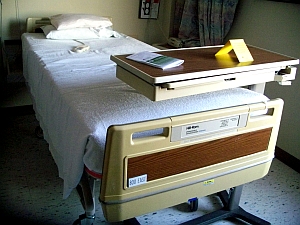 Researchers at Empa, a scientific institute in Switzerland, the Swiss Paraplegic Centre, and Schoeller Group, an advanced textiles company also in Switzerland, created a new type of bed linen that reduces the chance of bed sores developing on immobile patients. Schoeller Group’s medical division plans to introduce the new material as a commercial product next year.
Researchers at Empa, a scientific institute in Switzerland, the Swiss Paraplegic Centre, and Schoeller Group, an advanced textiles company also in Switzerland, created a new type of bed linen that reduces the chance of bed sores developing on immobile patients. Schoeller Group’s medical division plans to introduce the new material as a commercial product next year.
The skin, like the body in general, suffers from a lack of movement, which can be a particular problem for bed-ridden hospital patients such as the elderly or disabled. Lack of movement by a patient adds to higher moisture levels, pressure, and the effects of gravity, which contribute to circulatory disorders. These disorders increase the amount of toxic tissue, resulting in ulcers that can lead to complications. Empa says the elderly and disabled face a 50 percent greater chance of developing bed sores during a hospital stay.
The problem is acknowledged in the medical community, but solutions devised so far have not been fully effective or devices such as mattresses that mechanically change the area of pressure have proven to be overly expensive. Siegfried Derler, a physicist in Empa’s lab in St. Gallen, Switzerland led the project to find a different approach, building on his previous research with Schoeller Group on human skin and friction, but in this case also involved the Swiss Paraplegic Centre.
The team evaluated current synthetic fibers and developed a material with what Derler calls, “a kind of dot matrix surface.” This engineered surface provides fewer points of contact and less surface contact with the skin, as well as microscopic spaces between the dots that can absorb moisture. Empa’s test labs and Schoeller Group’s manufacturing facilities refined the fabric in multiple iterations before they felt ready to test the fabric on human patients.
The tests with 20 long-term hospitalized patients were conducted at the Swiss Paraplegic Centre in Nottwil, Switzerland over 18 months in 2010-11. Medical staff at the facility checked the patients’ blood circulation and watched for indicators of skin health, such as redness, elasticity, and moisture levels. The researchers also recorded the patients’ subjective well-being in questionnaires. The results indicate the patients using the bed linens with the new material sweated less, their blood circulation improved, and they felt significantly more comfortable than in conventional sheets.
Schoeller is submitting the new material to more rigorous real-life tests, including its ability to stand up to repeated use and washing. The company plans to introduce the material as a commercial product in the spring of 2013, and is now building an international distribution network for the product.
Read more:
- Lab Developing Fabric that Repels Chemical, Bio Agents
- University Prof. Develops Lightweight Pipeline Material
- Composite Nanofibers Developed for Orthopedic Biomaterials
- Australian Science Agency, Biotech Partner on Insect Silks
- Nanotech Fiber Material Converts Heat to Electricity
Photo: Jo Naylor/Flickr
* * *

 RSS - Posts
RSS - Posts
[…] High-Tech Sheet Fabric Developed to Reduce Bed Sore Risk […]